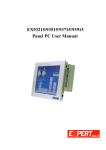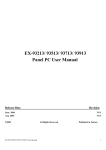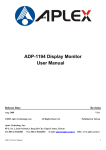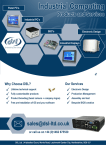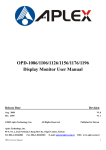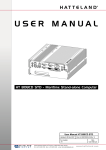Download Aplex APC-3515 User manual
Transcript
APC-3215/3515/3715/3915 Panel PC User Manual Release Date _ Oct. 2007 ®2005 Aplex Technology, Inc. Revision V0.1 All Rights Reserved. Published in Taiwan Aplex Technology, Inc. 9F-5, No. 2, Jian Pa Road, Chung Ho City, Taipei County, Taiwan Tel: 886-2-82262881 Fax: 886-2-82262883 E-mail: [email protected] URL: www.aplex.com.tw APC-3x15 User Manual 1 Warning!___________________________________ This equipment generates, uses and can radiate radio frequency energy and if not installed and used in accordance with the instructions manual, it may cause interference to radio communications. It has been tested and found to comply with the limits for a Class A computing device pursuant to FCC Rules, which are designed to provide reasonable protection against such interference when operated in a commercial environment. Operation of this equipment in a residential area is likely to cause interference in which case the user at his own expense will be required to take whatever measures may be required to correct the interference. Electric Shock Hazard – Do not operate the machine with its back cover removed. There are dangerous high voltages inside. Disclaimer This information in this document is subject to change without notice. In no event shall Aplex Technology Inc. be liable for damages of any kind, whether incidental or consequential, arising from either the use or misuse of information in this document or in any related materials. APC-3x15 User Manual 2 Packing List Accessories (as ticked) included in this package are: □ AC power cable □ Driver & manual CD disc □ Other.___________________(please specify) Safety Precautions Follow the messages below to prevent your systems from damage: ◆ Avoid your system from static electricity on all occasions. ◆ Prevent electric shock. Don‘t touch any components of this card when the card is power-on. Always disconnect power when the system is not in use. ◆ Disconnect power when you change any hardware devices. For instance, when you connect a jumper or install any cards, a surge of power may damage the electronic components or the whole system. APC-3x15 User Manual 3 Table of Contents______________________ Warning!…………………………………………………………………………….……..….2 Disclaimer………………………………………………………………….…………………2 Packing List…………………………………………………………………………………..3 Safety Precautions…………………………………………………………………………..3 Chapter 1 1.1 1.2 1.3 1.4 1.5 1.6 Chapter 2 Getting Started Specifications……………………………………….……………………..6 Dimensions………………………………...………………………….......8 Installation of CD-ROM & HDD…………………………………….…..12 Installation of PCI Addon………………………………………………..14 Brief Description…………………………………………………….……16 Panel Mounting…………………………………………………………..17 Hardware 2.1 Mainboard………………..…….……………………………………..…..18 2.2 Installations…….…………………………………….…………………...19 2.2.1 Installing CPU…….……………………...………………………….....19 2.2.2 Installing Memory………………………………………………..….....20 2.2.3 Installing Jumper…………………………………………………….....20 2.2.4 Connectors on Mainboard……………….…………………………....23 Chapter 3 BIOS Setup 3.1 BIOS Setup………….…………..…………………………………..…...…38 BIOS Introduction………………………………………………………...38 BIOS Setup………………………………………………………………38 Sta n d a r d CMOS S e t u p ………………………………….. … . . . 4 0 Advanced BIOS Features……………...………………………….......43 Advanced Chipset Features…………………………………………...46 Integrated Peripherals………..……………………………....49 Power Management Setup………………………………………..53 PnP/PCI Configuration………….………………….……….………....56 PC Health Status…………………………………………………….....57 Frequency/Voltage Control…………………………………………..58 Load Fail-Safe-Defaults….………………….………………...……....59 Load Optimized Defaults……...…………………………...................59 APC-3x15 User Manual 4 Set Supervisor Password………………………………..…...............59 Save & Exit Setup………………………………………………….…59 Exit without Saving……….………………….……….…………….…59 Chapter 4 Installation of Drivers 4.1 Intel Chipset Software Installation Utility.………………………………61 4.2 VGA Driver Installation……..………………...………………………..63 4.3 AC97 Codec Audio Driver Installation….……………………………….65 4.4 LAN Drivers Installation………………………………..…………………66 Chapter 5 Touch Screen Installation 5.1 Introduction to Controller Board..…………………………..……………68 5.2 Windows 2000/XP USB Driver Installation for 5000 Boards………..….68 5.3 Uninstall Windows 2000/XP USB Driver………………..………………..81 Figures Figure Figure Figure Figure Figure Figure Figure Figure Figure Figure Figure Figure Figure APC-3x15 User Manual 1.1: APC-3213 Dimensions……………………………………..…....8 1.2: APC-3513 Dimensions…………………………………………..9 1.3: APC-3713 Dimensions………………………………………….10 1.4: APC-3913 Dimensions………………………………………….11 1.5: Front View ……………………………………………………….16 1.6: Rear View………………………………………………………...16 1.7: Panel Mounting…………………………………………………..17 2.1: Mainboard Overview………………………………………….....18 2.2 Installation of CPU………………………………………………..19 2.3 Installation of Memory Module……………………………..……20 2.4 Location of Jumpers……………………………………..............21 2.5 Location of Connectors……………………………………….…..24 5.1 Birdeye’s View of Control Board…………………………………68 5 Chapter 1 System 1.1 Specifications Specs APC-3215 APC-3515 APC-3715 APC-3915 CPU Socket 478 Intel® Core™ Duo, up to 2.33GHz Cache 2MB Chipset Mobile Intel® 945GM Express + ICH7M Processor Side Bus Freq. 533MHz/667MHz FSB System Memory DDR2 667/533 SDRAM DIMM x2 (w/o ECC function), Max. 4GB Display Size 12.1” 800x600 TFT 15” 1024x768 TFT 17” 1280x1024 19” 1280x1024 TFT LCD LCD TFT LCD LCD Maximum Colors 262K 16.2M 16.2M 16.2M Viewing Angle (Degree) 55(left), 55(right), 60(left), 60(right), 70(left), 70(right), 80(left), 80(right), 35(up), 50(down) 40(up), 60(down) 63(up), 67(down) 75(up), 85(down) 300 350 300 420 Luminance (cd/m²) Backlight Lifetime 50,000 Hours Rating NEMA 4/IP65 certified Front Bezel Touch Screen Type 8-Wire Resistive (optional) Serial Port 1 x COM Port USB Port 4 x USB2.0 Port Serial ATA Parts ICH7M Built-in SATA controller, supports 2 ports 1394 Port TI TSB43LV22(dual port) Storage 1 x 2.5” HDD or 1 x CF by TB-405 (Optional), 1 x Slim CD-ROM/DVD Combo Keyboard & Mouse 1 x PS/2 Keyboard and Mouse Connectors Digital I/O 4 in/4 out (optional) BIOS Award 4Mbit BIOS, support ACPI Function Watchdog Timer 256 levels LAN 1 x 10/100 BaseT LAN, 1 x PCI Express Gigabit LAN VGA 1 x external VGA, 945GM built-in Expansion Slot 2 x PCI Expansion Slot IDE Interface ICH7M built-in one channel Ultra DMA 33/66/100,CF Audio ICH7M Built-in Audio controller + AC97 Codec ALC655 w/ 6 channels (Line-out, Line-in, Mic.) Power Supply 220W/ 0.8U ATX/AC Construction and Color Steel Chassis and Beige Dimensions (WxHxD) APC-3x15 User Manual 390 x 265 x 111 410 x 310 x 111 457 x 355 x 123 484 x 400 x 139.5 6 Operating Temperature 0~60℃ (32℉~140℉) Storage Temperature -20℃~ 80℃ (-68℉~176℉) Relative Humidity 10%~90% (non-condensing) Vibration 5~17Hz, 0.1” double amplitude displacement 17~640Hz, 1.5G acceleration peak to peak Shock APC-3x15 User Manual 10G acceleration peak to peak (11 millimeters) 7 1.2 Dimensions Figure 1.1: Dimensions of the APC-3215 APC-3x15 User Manual 8 Figure 1.2: Dimensions of the APC-3515 APC-3x15 User Manual 9 Figure 1.3: Dimensions of the APC-3715 APC-3x15 User Manual 10 Figure 1.4: Dimensions of the APC-3915 APC-3x15 User Manual 11 1.3 Installation of CD-ROM & HDD Both of 2 at the right side There are 8 screws to deal with when enclosing or removing the chassis. Shown in the picture are the four screws (as circled in red) that tighten or loosen the bracket where the CD-ROM is placed underneath. On top of the bracket is where the HDD is placed. To remove the CD-ROM, the HDD has to be removed first. CD-ROM Now slide the HDD into the bracket as shown in the picture. After that, connect the HDD to the 44-pin black IDE by means of the cable, making sure the red stripe of the cable is connected to the pin 1 of the connector of the HDD APC-3x15 User Manual 12 The red circles shown in the picture are the screws that put the CD-ROM in place. The arrows shown are where the HDD, which is just placed on top of the CD-ROM, is tightened. APC-3x15 User Manual 13 1.4 Installation of PCI Addon Shown in the picture are the two PCI expansion slots as circled. They can be inserted with any addon for expanded functions. Now slide the addon into the PCI slot, making sure the golden part faces the slot. When both parts that are interfaced together come into the right contact, slightly push the addon into the rail of the slot. This shows the addon is already completely connected. After sliding the addon into the PCI expansion slot, get the two screws as circled tightened to finish the connection. APC-3x15 User Manual 14 Both of 2 at the right side To finish the job, just fasten the 8 screws as shown in the picture. APC-3x15 User Manual 15 1.5 Brief Description of the APC-3215/3515/3715/3915 The APC-3215/3515/3715/3915 is a rugged, compact and panel-mount industrial PC, which comes with a 12-inch (luminance of 300 cd/m²)/15-inch (luminance of 350 cd/m²)/17-inch (luminance of 300 cd/m²)/19-inch (luminance of 420 cd/m²) TFT LCD. It is powered by an Intel® Core™ Duo, up to 2.33GHz processor. The industrial panel PC also features two PCI expansion slots, one COM port, four USB 2.0 ports, one 2.5” HDD, one slim CD-ROM/DVD Combo, Universal AC power of 100~240V, etc. It is ideal for use as a PC-based controller for Automotive, Logistic Process, Materials Handling, and Kiosk applications. Figure 1.5: Front View of APC-3215/3515/3715/3915 TV-Out PS/2 Mouse COM VGA PS/2 KB AC Power SPDIF Out LAN 2 x USB GbE LAN 2 x USB Audio Power Switch 1394 COM SPDIF Out Reset HDD LED Power LED Figure 1.6: Rear View of APC-3215/3515/3715/3915 APC-3x15 User Manual 16 1.6 Panel Mounting of the APC-3215/3515/3715/3915 The APC-3215/3515/3715/3915 panel PC is designed to be panel-mounted as shown in Figure 1.6. Just carefully place the unit through the hole and tighten the given 8 screws from the rear to secure the mounting. Figure 1.6: Panel mounting of the APC-3215/3515/3715/3915 APC-3x15 User Manual 17 Chapter 2 Hardware 2.1 Mainboard Figure 2.1: Mainboard Overview APC-3x15 User Manual 18 2.2 Installations This section provides information on how to use the jumpers and connectors on the mainboard in order to set up a workable system. 2.2.1 Installing the CPU The mainboard supports a Socket 478MT (Napa) processor socket for Intel® CoreTM 2 Duo , Intel® CoreTM Duo and Intel® CoreTM Solo mobile processors. The processor socket comes with a screw to secure the processor. As shown in the left picture below, loosen the screw first before inserting the processor. Place the processor into the socket by making sure the notch on the corner of the CPU corresponds with the notch on the inside of the socket. Once the processor has slide into the socket, fasten the screw. Refer to the figures below. Figure 2.2: Installation of CPU Note: Ensure that the CPU heat sink and the CPU top surface are in total contact to avoid CPU overheating problem that would cause your system to hang or be unstable. APC-3x15 User Manual 19 2.2.2 Installing the Memory The mainboard supports two DDR2 memory socket for a maximum total memory of 4GB in DDR2 memory type. Installing and Removing Memory Modules To install the DDR2 modules, locate the memory slot on the board and perform the following steps: 1. Hold the DDR2 module so that the key of the DDR2 module align with those on the memory slot. 2. Gently push the DDR2 module in an upright position until the clips of the slot close to hold the DDR2 module in place when the DDR2 module touches the bottom of the slot. 3. To remove the DDR2 module, press the clips with both hands. Figure 2.3: Installation of Memory Module 2.2.3 Installing the Jumpers Jumpers are used on MB899 to select various settings and features according to your needs and applications. Contact your supplier if you have doubts about the best configuration for your needs. The following lists the connectors on MB899 and their respective functions. Jumper Locations on Mainboard JP2: CPU FSB Selection (reserved) JP5: LCD Panel Power Selection JP6: 1394 EPROM Write Selection JP7: Clear CMOS Setting JP8: Compact Flash Slave/Master Selection APC-3x15 User Manual 20 IMPORTANT NOTE: When the system boots without the CRT being connected, there will be no image on screen when you insert the CRT/VGA cable. To show the image on screen, the hotkey must be pressed. Figure 2.4: Location of Jumpers APC-3x15 User Manual 21 APC-3x15 User Manual 22 2.2.4 Connectors on the Mainboard The connectors on mainboard allows you to connect external devices such as keyboard, floppy disk drives, hard disk drives, printers, etc. The following table lists the connectors on MB899 and their respective functions. CN1: PS/2 Keyboard and PS/2 Mouse Connectors CN2, CN3: COM1 and VGA Connector CN4: 10/100 RJ-45 and USB1/2 Ports CN5: 1394 Connector J12: SPDIF Out Connector CN6,CN7: GbE RJ-45 and USB3/4 Ports CN8: Audio Connector CN9, CN10: Serial ATA Connectors FAN1: System Fan Power Connector FAN2: CPU Fan Power Connector IDE1: IDE Connector FDD1: Floppy Drive Connector J14: ATX Power Supply Connector J1: IrDA Connector J2: Digital I/O J3: System Function Connector J4: TV-OUT (S-VIDEO & Composite) Connector J5: TV-OUT (Y,Pr,Pb) Connector J6: USB5/6 Port Pin Header J7: COM2 Serial Port J8: Wake On LAN Connector J9, J10: LVDS Connectors (1st channel, 2nd channel) J11: LCD Backlight Connector J13: Mini PCI Connector U36: Mini PCI- E(x1) Connector J15: Speaker Connector J16: 1394 Connector J17: Front Audio Connector J18: PCI-E(x1) Slot J19: CD-In Pin Header J20: Compact Flash Connector PCI1: PCI Slot (supports 2 Master) CON1: SDVO Port Connector Headers and Connectors on MB899 Daughter Cards APC-3x15 User Manual 23 Figure 2.5: Location of Connectors APC-3x15 User Manual 24 APC-3x15 User Manual 25 APC-3x15 User Manual 26 APC-3x15 User Manual 27 APC-3x15 User Manual 28 APC-3x15 User Manual 29 APC-3x15 User Manual 30 APC-3x15 User Manual 31 APC-3x15 User Manual 32 APC-3x15 User Manual 33 APC-3x15 User Manual 34 APC-3x15 User Manual 35 APC-3x15 User Manual 36 APC-3x15 User Manual 37 Chapter 3 BIOS Setup 3.1 BIOS Setup This chapter describes the different settings available in the Award BIOS that comes with the board. The topics covered in this chapter are as follows: BIOS Introduction BIOS Setup Standard CMOS Setup Advanced BIOS Features Advanced Chipset Features Integrated Peripherals Power Management Setup PNP/PCI Configurations PC Health Status Frequency/Voltage Control Load Fail-Safe Defaults Load Optimized Defaults Set Supervisor/User Password Save & Exit Setup Exit Without Saving BIOS Introduction The Award BIOS (Basic Input/Output System) installed in your computer system’s ROM supports Intel processors. The BIOS provides critical low-level support for standards devices, such as disk drives, serial ports and parallel ports. It also adds virus and password protection as well as special support for fine-tuning the chipset controlling the entire system. BIOS Setup The Award BIOS provides a Setup utility program for specifying the system configurations and settings. The BIOS ROM of the system stores the Setup utility. When you on the computer, the Award BIOS is immediately activated. Pressing the <Del> key immediately allows you to enter the Setup utility. If you are a little bit late to press the <Del> key, POST (Power On Self Test) will continue with its test routines, thus preventing you from invoking the Setup. If you still wish to enter Setup, restart the system by the pressing the “Reset” button or simultaneously pressing the <Ctrl>, <Alt> and <Del> keys. You can also restart by turning the system off and back on again. The following message will appear on the APC-3x15 User Manual 38 screen: Press <DEL> to Enter Setup In general, you press the arrow keys to highlight items, <Enter> to select, the <PgUp> and <PgDn> keys to change entries, <F1> for help and <Esc> to quit. When you enter the Setup utility, the Main Menu screen will appear on the screen. The Main Menu allows you to select from various Setup functions and exit choices. The section below the Setup items of the Main Menu displays the control keys for this menu. At the bottom of the Main Menu just below the control key section there is another section displaying information on the currently-highlighted item in the list. Note: If the system cannot boot after making and saving system changes with Setup, the Award BIOS supports an override to the CMOS settings that reset your system to its default. Warning: It is strongly recommended that you avoid making any changes to the chipset defaults. These defaults have been carefully chosen by both Award and your system manufacturer to provide the absolute maximum performance and reliability. Changing the defaults could cause the system to become unstable and crash in some cases. APC-3x15 User Manual 39 Standard CMOS Setup “Standard CMOS Setup” choice allows you to record some basic hardware configurations in your computer system and set the system clock and error handling. If the motherboard is already installed in a working system, you will not need to select this option. You will need to run the Standard CMOS option; however, if you change your system hardware configurations, the onboard battery fails, or the configuration stored in the CMOS memory was lost or damaged. At the bottom of the menu are the control keys for use on this menu. If you need any help in each item field, you can press the <F1> key. It will display the relevant information to help you. The memory display at the lower right-hand side of the menu is read-only. It will adjust automatically according to the memory changed. The following describes each item of this menu: Date The date format is: Day: Month: Date: Year: Sun to Sat 1 to 12 1 to 31 1999 to 2099 To set the date, highlight the “Date” field and use the PageUp/PageDown or +/- keys to set the current APC-3x15 User Manual 40 time. Time The time format is: Hour: 00 to 23 Minute: 00 to 59 Second: 00 to 59 To set the time, highlight the “Time” field and use the <PgUp>/<PgDn> or +/- keys to set the current time. IDE Primary HDDs/IDE Secondary HDDs The onboard PCI IDE connectors provide Primary and Secondary channels for connecting up to four IDE hard disks or other IDE devices. Each channel can support up to two hard disks; the first is the “Master” while the second, the “Slave”. Press <Enter> to configure the hard disk. The selections include Auto, Manual, and None. Select “Manual” to define the drive information manually. You will be asked to enter the following items: CYLS: Number of cylinders HEAD: PRECOMP: LANDING ZONE: SECTOR: Number of read/write heads Write precompensation Landing zone Number of sectors The Access Mode selections are as follows: CHS (HD<528MB) LBA (HD>528MB and supports Logical Block Addressing) Large (for MS-DOS only) Auto Remarks: The mainboard supports two serial ATA ports and are represented in this setting as IDE channel 0. Drive A /Drive B These fields identify the types of floppy disk drive A or drive B that has been installed in the computer. The available specifications are: 360KB 5.25 in 1.2MB 5.25 in 720KB 3.5 in 1.44MB 3.5 in 2.88MB 3.5 in Video This field selects the type of video display card installed in your system. You can choose the following video display cards: APC-3x15 User Manual 41 EGA/VGA CGA 40 CGA 80 MONO for EGA, VGA, SEGA, SVGA Or PGA monitor adapters (default) Power up in 40 column mode Power up in 80 column mode for Hercules or MDA adapters Halt On This field determines whether or not the system will halt if an error is detected during power up. No errors The system boot will not be halted for any error that may be detected. All erros Whenever the BIOS detects a non-fatal error, the system will stop and you will be prompted. All, but Keyboard The system boot will not be halted for a keyboard Error; it will stop for all other errors. All, but Diskette The system boot will not be halted for a disk error; it will stop for all other errors. All, but Disk/Key The system boot will not be halted for a keyboard or disk error; it will stip for all others. APC-3x15 User Manual 42 Advanced BIOS Features This section allows you to configure and improve your system and allows you to set up some system features according to your preference. CPU Feature Press Enter to configure the settings relevant to CPU Feature. Hard Disk Boot Priority With the field, there is the option to choose, aside from the hard disks connected, “Bootable add-in Cards” which refers to other external devices. Virus Warning If this option is enabled, an alarm message will be displayed when trying to write on the boot sector or on the partition table on the disk, which is typical of the virus. CPU L1 and L2 Cache Cache memory is additional memory that is faster than conventional DRAM (system memory). CPUs from 486-type on up contain internal cache memory,and most, but not all, modern PCs have additional (external) cache memory. When the CPU requests data, the system transfers the requested data from the main DRAM into cache memory, for even faster access by the CPU. These allow you to enable (speed up memory access) or disable the cache function. APC-3x15 User Manual 43 Quick Power On Self Test When enabled, this field speeds up the Power On Self Test (POST) after the system is turned on. If it is set to Enabled, BIOS will skip some items. First/Second/Third Boot Device These fields determine the drive that the system searches first for an operating system. The options available include Floppy, LS120, Hard Disk, CDROM, ZIP100, USB-Floppy, USB-ZIP, USB-CDROM, LAN and Disable. Boot Other Device These fields allow the system to search for an OS from other devices other than the ones selected in the First/Second/Third Boot Device. Swap Floppy Drive This item allows you to determine whether or not to enable Swap Floppy Drive. When enabled, the BIOS swaps floppy drive assignments so that Drive A becomes Drive B, and Drive B becomes Drive A. By default, this field is set to Disabled. Boot Up Floppy Seek This feature controls whether the BIOS checks for a floppy drive while booting up. If it cannot detect one (either due to improper configuration or its absence), it will flash an error message. Boot Up NumLock Status This allows you to activate the NumLock function after you power up the system. Gate A20 Option This field allows you to select how Gate A20 is worked. Gate A20 is a device used to address memory above 1 MB. Typematic Rate Setting When disabled, continually holding down a key on your keyboard will generate only one instance. When enabled, you can set the two typematic controls listed next. By default, this field is set to Disabled. Typematic Rate (Chars/Sec) When the typematic rate is enabled, the system registers repeated keystrokes speeds. Settings are from 6 to 30 characters per second. Typematic Delay (Msec) When the typematic rate is enabled, this item allows you to set the time interval for displaying the first and second characters. By default, this item is set to 250msec. APC-3x15 User Manual 44 Security Option This field allows you to limit access to the System and Setup. The default value is Setup. When you select System, the system prompts for the User Password every time you boot up. When you select Setup, the system always boots up and prompts for the Supervisor Password only when the Setup utility is called up. APIC Mode APIC stands for Advanced Programmable Interrupt Controller. The default setting is Enabled. MPS Version Control for OS This option is specifies the MPS (Multiprocessor Specification) version for your operating system. MPS version 1.4 added extended configuration tables to improve support for multiple PCI bus configurations and improve future expandability. The default setting is 1.4. OS Select for DRAM > 64MB This option allows the system to access greater than 64MB of DRAMmemory when used with OS/2 that depends on certain BIOS calls to access memory. The default setting is Non-OS/2. Report No FDD For WIN 95 If you are using Windows 95/98 without a floppy disk drive, select Enabled to release IRQ6. This is required to pass Windows 95/98's SCT test. You should also disable the Onboard FDC Controller in the Integrated Peripherals screen when there's no floppy drive in the system. If you set this feature to Disabled, the BIOS will not report the missing floppy drive to Win95/98. Small Logo (EPA) Show The EPA logo appears at the right side of the monitor screen when the system is boot up. The default setting is Enabled. APC-3x15 User Manual 45 Advanced Chipset Features APC-3x15 User Manual 46 APC-3x15 User Manual 47 APC-3x15 User Manual 48 APC-3x15 User Manual 49 APC-3x15 User Manual 50 APC-3x15 User Manual 51 APC-3x15 User Manual 52 APC-3x15 User Manual 53 APC-3x15 User Manual 54 APC-3x15 User Manual 55 APC-3x15 User Manual 56 APC-3x15 User Manual 57 APC-3x15 User Manual 58 APC-3x15 User Manual 59 Chapter 4 Installation of Drivers This chapter describes the installation procedures for software and drivers under the Windows 98SE, Windows ME, Windows 2000 and Windows XP. The software and drivers are included with the motherboard. The contents include Intel Chipset Software Installation Utility, VGA Drivers Installation, AC97 Codec Audio Driver Installation, and Intel PRO LAN Drivers Installation. Important Note: After installing your Windows operating system (Windows 98SE/ME/2000/XP), you must install first the Intel Chipset Software Installation Utility before proceeding with the installation of drivers. I APC-3x15 User Manual 60 4.1 Intel Chipset Software Installation Utility The Intel Chipset Drivers should be installed first before the software drivers to enable Plug & Play INF support for Intel chipset components. Follow the instructions below to complete the installation under Windows 2000/XP. 1. Insert the CD that comes with the board. Click Intel Chipsets and then Intel(R) I945GMChipset Drivers. 2. Click Intel(R) Chipset Software Installation Utility. 3. When the Welcome screen appears, click Next to continue. APC-3x15 User Manual 61 4. Click Yes to accept the software license agreement and proceed with the installation process. 5. On Readme Information screen, click Next to continue the installation. 6. The Setup process is now complete. Click Finish to restart the computer and for changes to take effect. When the computer has restarted, the system will be able to find some devices. Restart your computer when prompted. APC-3x15 User Manual 62 4.2 VGA Driver Installation To install the VGA drivers, follow the steps below to proceed with the installation. 1. Insert the CD that comes with the motherboard. Click Intel Chipsets and then Intel(R) I945GM Chipset Drivers. 2. Click Intel(R) I945GM Chipset Family Graphics Driver. 3. When the Welcome screen appears, click Next to continue. APC-3x15 User Manual 63 4. Click Yes to to agree with the license agreement and continue the installation. 5. Restart the computer as promted and for changes to take effect. IMPORTANT NOTE: When you have restarted the computer, your computer screen will be blank. At this point, press CTRL-ALT-F1 simultaneously, if you are using CRT monitor. If you are using LVDS LCD panel, press CTRL-ALT-F3. If you are using DVI monitor, press CTRL-ALT-F4. APC-3x15 User Manual 64 4.3 AC97 Codec Audio driver Installation Follow the steps below to install the Realtek AC97 Codec Audio Drivers. 1. Insert the CD that comes with the motherboard. Click Intel Chipsets and then Intel(R) I945GMChipset Drivers. 2. Click Realtek AC'97 Codec Audio Driver. 3. Click Finish to restart the computer and for changes to take effect. APC-3x15 User Manual 65 4.4 LAN Driver Installation Follow the steps below to complete the installation of the Intel PRO LAN drivers. 1. Insert the CD that comes with the motherboard. Click Intel Chipsets and then Intel(R) I945GMChipset Drivers, then Intel(R) PRO LAN Network Drivers. 2. Click Install Base Software to continue. APC-3x15 User Manual 66 3. When prompted, please to restart the computer for new settings to take effect. Follow the steps below to install the Marvell Gigabit LAN drivers. 1. Insert the CD that comes with the motherboard. Click LAN Card andthen Marvell LAN Controller Driver. 2. Click Next when the InstallShield Wizard welcome screen appears. 3. Click Next to agree with the license agreement. 4. Click Next when the Readme Information screen appears to proceed with the drives installation process. 5. When the Installation is complete, click Finish for the changes to take effect. APC-3x15 User Manual 67 Chapter 5 Touch Screen Installation This chapter describes how to install drivers and other software that will allow your PenMount 5000 Controller Board (USB) to work with different operating systems. NOTE: PenMount USB drivers support up to 15 USB controllers. 5.1 Introduction to Touch Screen Controller Board The control board is configured for use with the USB interface. It connects to the touch screen, power supply and computer system’s USB port, and supports 4-, 5- and 8-wire touch screens. The control board has some advanced functions, such as PnP and non-PnP mode adjustable baud rate, thus making easy for customers to select different touch screens without changing the control board. The size of the board is 25 by 60mm, and it has two connectors and one dipswitch on-board. Figure 5.1: Bird’s Eye View of Control Board 5.2 Windows Me/2000/XP USB Driver Installation for 5000 Boards Before installing the Windows Me/2000/XP USB driver software, you must have the Windows Me/2000/XP system installed and running on your computer. You must also have one of the following PenMount USB controller boards installed: 5184 or 51A5. Contents of the PenMount Windows Me/2000/XP USB driver folder are listed below. Setup.exe PenMount 98.inf PenMount.inf Pm_lower.sys Pm_upper.sys If you have an older version of the PenMount Windows Me/2000/XP USB driver installed in your APC-3x15 User Manual 68 system, please remove it first. Follow the steps below to install the PenMount Windows Me/2000/XP USB driver. 5.2.1 Insert the Aplex product cd install setup.exe. the screen below would appear. Click touch panel driver IMPORTANT! Before installing the driver software you must plug the board into a USB port. APC-3x15 User Manual 69 5.2.2 The screen displays ‘InstallShield Wizard’ to install the PenMount Windows Me/2000/XP driver. Click ‘Next’ to begin installing the PenMount USB driver to system. 5.2.3 The license agreement appears. Click ‘Next’. APC-3x15 User Manual 70 5.2.4 The next screen shows ‘Ready to Install the Program’. Click ‘Install’. 5.2.5 The ‘InstallShield Wizard completed’ screen appears. Click ‘Finish’. APC-3x15 User Manual 71 5.2.6 A message box appears stating the driver does not have an MS Logo. Select ‘Continue Anyway’ to finish the installation. The PenMount USB driver is now completely installed. Configuring the PenMount Windows Me/2000/XP USB Driver Upon rebooting, the computer automatically finds the new 5000 USB controller board. The touch screen is connected but not calibrated. Follow the procedures below to carry out calibration. 5.2.6.1 After installation, click the PenMount Monitor icon “PM” in the menu bar. 5.2.6.2 When the PenMount Control Panel appears, click “Calibrate.” APC-3x15 User Manual 72 PenMount Control Panel The functions of the PenMount Control Panel are Calibrate, Draw, and About, which are explained in the following sections. Calibrate This function offers two ways to calibrate your touch screen. ‘Standard Calibration’ adjusts most touch screens. ‘Advanced Calibration’ adjusts aging touch screens. Standard Calibration Click this button and arrows appear pointing to red squares. Use your finger or stylus to touch the red squares in sequence. After the fifth red point calibration is complete. To skip, press ‘ESC’. Advanced Calibration Advanced Calibration uses 4, 9, 16 or 25 points to effectively calibrate touch panel linearity of aged touch screens. Click this button and touch the red squares in sequence with a stylus. To skip, press ESC’. NOTE: The older the touch screen, the more Advanced Mode calibration points you need for an accurate calibration. Use a stylus during Advanced Calibration for greater accuracy. APC-3x15 User Manual 73 APC-3x15 User Manual 74 Plot Calibration Data Check this function and a touch panel linearity comparison graph appears when you have finished Advanced Calibration. The blue lines show linearity before calibration and black lines show linearity after calibration. Draw Tests or demonstrates the PenMount touch screen operation. The display shows touch location. Click Draw to start. APC-3x15 User Manual 75 Touch the screen with your finger or a stylus and the drawing screen registers touch activity such left, right, up, down, pen up, and pen down. Click Clear Screen to clear the drawing. APC-3x15 User Manual 76 Options This panel function supports two modes—Operation Mode and Beep Sound Mode—which allow configuration for specific touch screen applications, such as point-of-sales (POS) terminals. Operation Mode This mode enables and disables the mouse’s ability to drag on-screen icons—useful for configuring POS terminals. Stream Mode – Select this mode and the mouse functions as normal and allows dragging of icons. Point Mode – Select this mode and the mouse only provides a click function, and dragging is disabled. eep Sound Mode Enable Beep Sound – turns beep function on and off Beep on Pen Down – beep occurs when pen comes down Beep on Pen Up – beep occurs when pen is lifted up Beep on both of Pen Down/Up – beep occurs on both Beep Frequency – modifies sound frequency Beep Duration – modifies sound duration APC-3x15 User Manual 77 About This panel displays information about the PenMount controller and driver version. PenMount Monitor Menu Icon The PenMount monitor icon (PM) appears in the menu bar of Windows Me/2000/XP system after the Windows Me/2000/XP USB driver is installed. PenMount Monitor has the following functions. APC-3x15 User Manual 78 Beep Turns touch screen beep on or off. Right Button When you select this function, a mouse icon appears in the right-bottom of the screen. Click this icon to switch between Right and Left Button functions. Exit Exits the PenMount Monitor function. PenMount Rotating Functions The PenMount driver for Windows Me/2000/XP supports several display rotating software packages. Please see Chapter 5 for more information. The PenMount drivers for Windows 95, Windows 98/Me, Windows 2000/XP, as well as Windows 98 USB and Windows Me/2000/XP support display rotating software packages such as: ◎Portrait’s Pivot Screen Rotation Software ◎ATI Display Driver Rotate Function ◎nVidia Display Driver Rotate Function ◎SMI Display Driver Rotate Function ◎Intel 845G/GE Display Driver Rotate Function APC-3x15 User Manual 79 Configuring the Rotate Function 1. Install the rotation software package. 2. Choose the rotate function (0°, 90°, 180°, 270°) in the 3rd party software. The calibration screen appears automatically. Touch this point and rotation is mapped. NOTE: The Rotate function is disabled if you use Monitor Mapping. APC-3x15 User Manual 80 5.3 Uninstall the PenMount Windows Me/2000/XP USB driver 1. Exit the PenMount monitor (PM) in the menu bar. 2. Remove the PenMount USB driver from “Start/Control Panel/Add/Remove Programs. Select ‘PenMount USB’ and click ‘Remove’. 3. Click ‘Yes’ to confirm removal of the driver and the PenMount Windows 98 USB driver is completely removed from the system. APC-3x15 User Manual 81




















































































